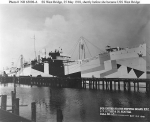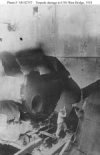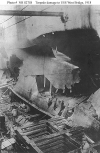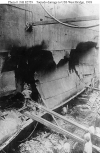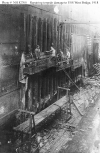NavSource Online:
Identification Numbered Vessel Photo Archive
West Bridge (ID 2888)
Love - King - Rush - Quack |
King - Jig - Option - Option |
Freighter:
Specifications:
| Commanding Officers | ||
| 01 | LCDR Mortimer Hawkins, USNRF | 26 May 1918 |
| 02 | LCDR Harry Allen Davis Cameron, USNRF | 1919 - 1 December 1919 |
|
|
Assigned to the Naval Overseas Transportation Service (NOTS), West Bridge got underway on 10 June bound for the east coast with a cargo of flour. Developing engine trouble as she steamed toward the Panama Canal, the freighter put into Balboa, Canal Zone, for repairs which took until 4 July before she resumed her voyage. The ship reached New York on 16 July, replenished her fuel, and sailed for France with Convoy HB-8 on 1 August.
Escorted by Noma (SP-131) and French cruiser Marseille, the convoy plodded across the Atlantic. By mid-August, the Allied ships entered the danger zone where U-boats had been highly active of late. In fact, two German submarines, U-90 and U-107, were then lurking in the path of the convoy.
At 1740 on the 16th, West Bridge's turbine broke down and defied all attempts at repair. As the ship dropped back within the convoy, Lt. Comdr. Hawkins notified the convoy commodore of West Bridge's plight. He also signaled Marseille that his ship needed a tow.
Meanwhile, the convoy continued on its way, when suddenly--shortly before 1800 and four miles ahead of the now drifting West Bridge--German submarine U-90 torpedoed Montanan.
At this juncture, Hawkins ordered general quarters and directed all hands to keep a sharp lookout, while also reducing the crew in the engine spaces to a minimum. Noma closed West Bridge and stood by the disabled freighter. On Noma's orders, West Bridge darkened ship and prepared for the worst.
Meanwhile, U-107 approached unseen and launched two torpedoes. One hit West Bridge forward near number 3 hold and the other amidships abreast of the engine room. A warning about torpedo tracks, shouted from the pilot house, was too late, and, almost simultaneously with the general alarm, the deadly "fish" struck their mark. The stricken freighter immediately took on water and commenced to sink, initially listing to starboard. Hawkins ordered "abandon ship," and the crew took to the boats. Hawkins and two crewmen remained behind until they felt sure that all the survivors were off and then joined the rest of the men in the water as waves began lapping over the gunwales onto the well deck.
Noma sped off in the direction from which the torpedoes had come and subjected the U-boat to a heavy depth charge barrage. The doughty patrol craft also sent out an "SOS" for West Bridge, since the shock of the initial explosion had disabled the freighter's wireless. In the interim, West Bridge's boats pulled about one mile away from the sinking ship, where the survivors watched the ship slowly settle.
West Bridge remained afloat for the rest of the night, and the dawn revealed the cargo vessel extremely low in the water but on an even keel. Noma returned from her submarine hunt and signaled that help was on the way. She herself had just rescued the survivors of the torpedoed Montanan.
One hour later, Burrows (Destroyer No. 29) appeared on the scene and picked up West Bridge's crew. A head count showed that four men were missing but turned up two women stowaways. After boarding Burrows, Commander Hawkins consulted with the destroyer's commanding officer and requested that he and his executive officer be allowed to return to West Bridge to determine whether or not the ship could be saved. Accordingly they were boated back to the freighter and boarded her. They found that both her well decks were awash, her engineering spaces were flooded, and at least three holds were totally inundated. Deeming the situation hopeless, Hawkins advised Burrows' commander that to stand by the drifting hulk would only endanger the lives of Burrows' crew and of West Bridge's survivors. Accordingly, Burrows proceeded for Brest, leaving Smith (Destroyer No. 17) to stand by the still floating Montanan (which soon sank) and West Bridge.
A volunteer work-and-salvage party from Smith, led by Lt. Richard L. Conolly, boarded West Bridge, while four tugs--two French, one British, and one American --set out from the French coast to assist. Soon thereafter, lsabel (Patrol Yacht No. 10) joined the convoy which arrived at Brest on 22 August. After being towed 400 miles in this condition, West Bridge had made it to port with only one-percent buoyancy remaining!
After extensive repairs which were completed in March 1919, West Bridge served with NOTS until 1 December when the cargo vessel was decommissioned and returned to the United States Shipping Board. She remained in the custody of that agency until abandoned in 1928.
| Back to the Main Photo Index | Back to the Identification Numbered Vessel (ID) Photo Index |
| Comments, Suggestions, E-mail Webmaster |
|
This page created by Joseph M. Radigan and maintained by David Wright |

